i need to play a role as A "lawyer" for (INTEL MICROELECTRONICS(M) SDN.BHD COMPANY & DEBATE THE DISMISSIAL LAW PLEASE HELP ME TO WRITE MY SCRIP aT LEAST ONE PAGE WITH ACCURATE INFORMAATION,THANK YOU, Here i am giving the case ,please write for me at least one page or half page with accurate information so that i can play my role As as A "lawyer" for (INTEL MICROELECTRONICS(M) SDN.BHD COMPANY & DEBATE THE DISMISSIAL LAW ,thank you.
The case

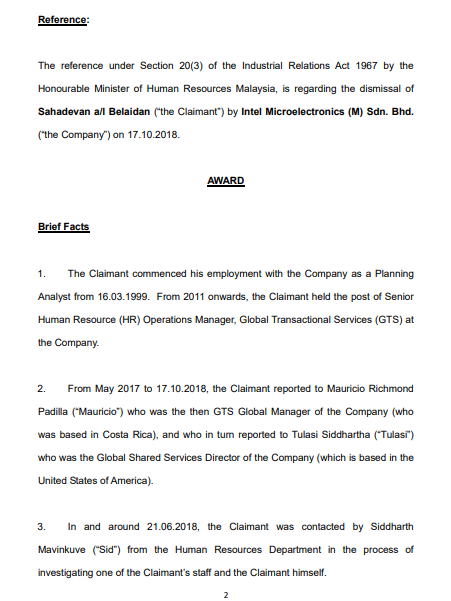

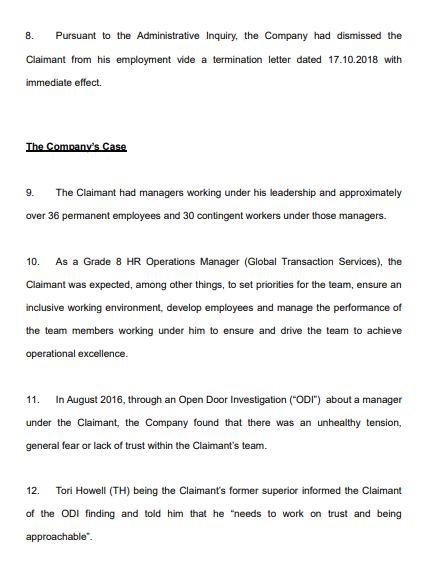
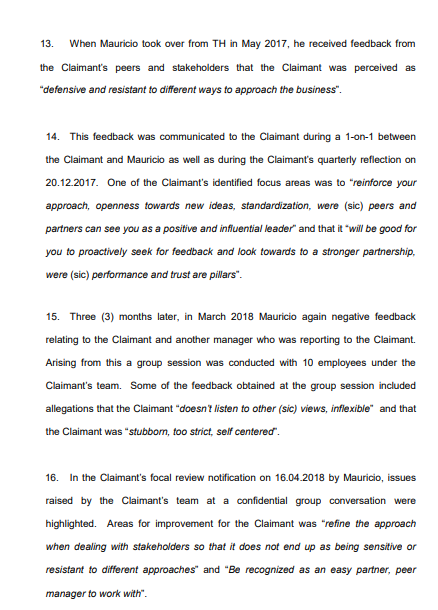

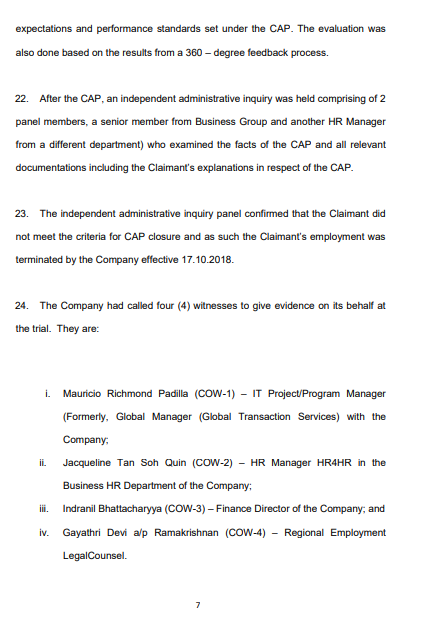
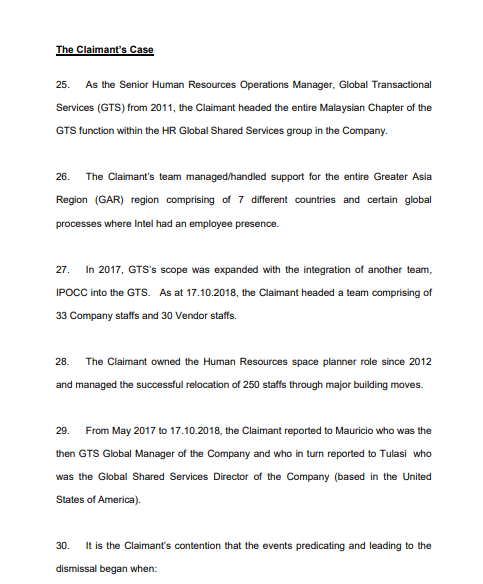

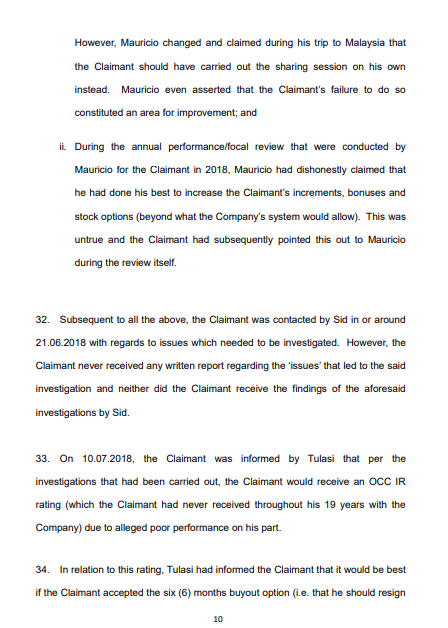
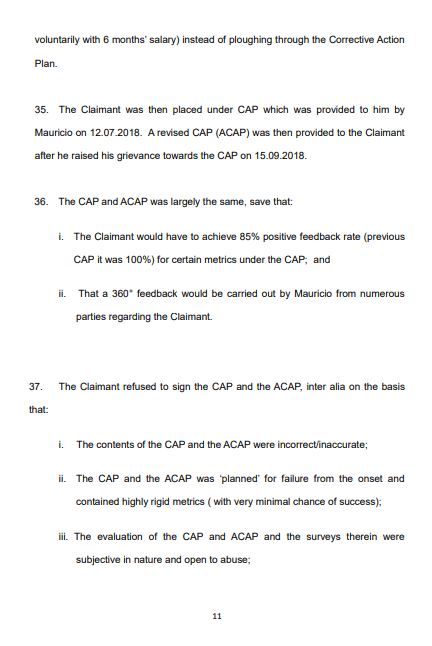
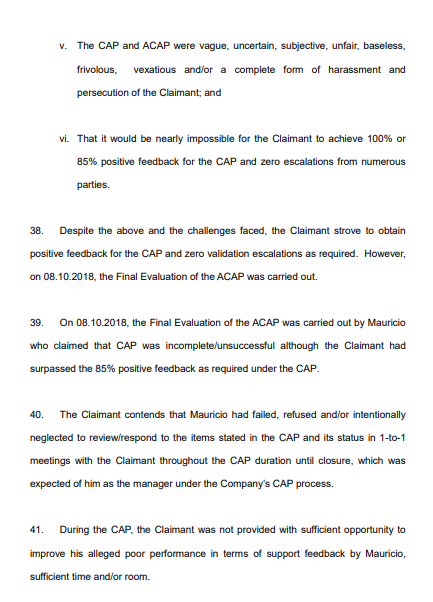
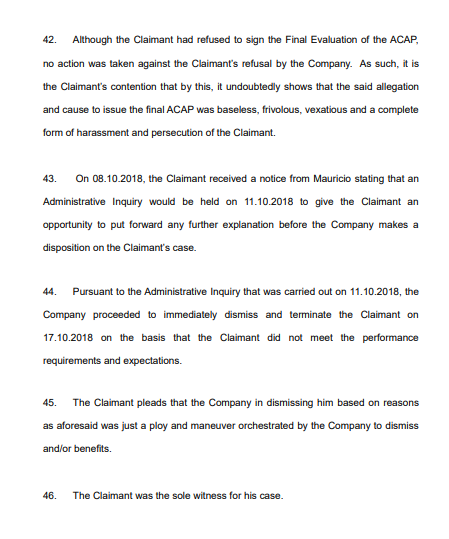
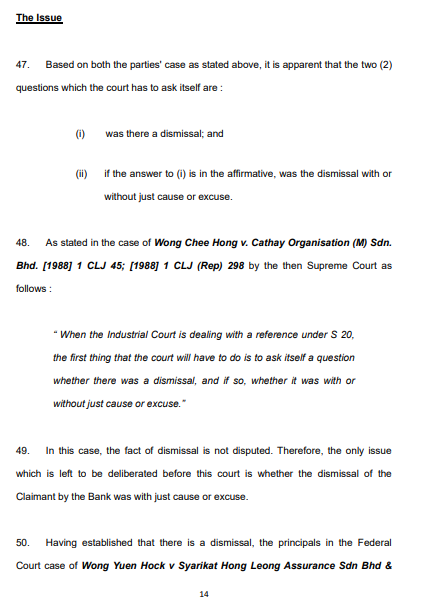
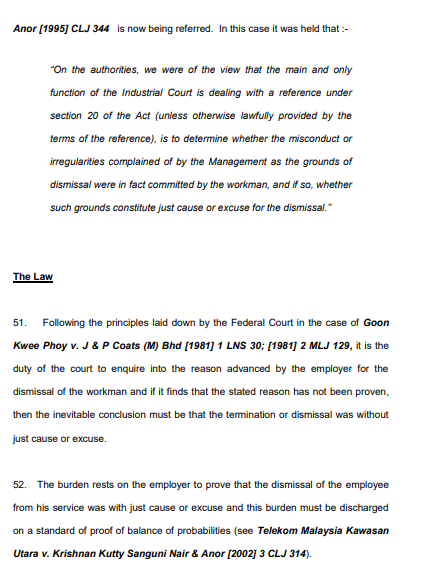
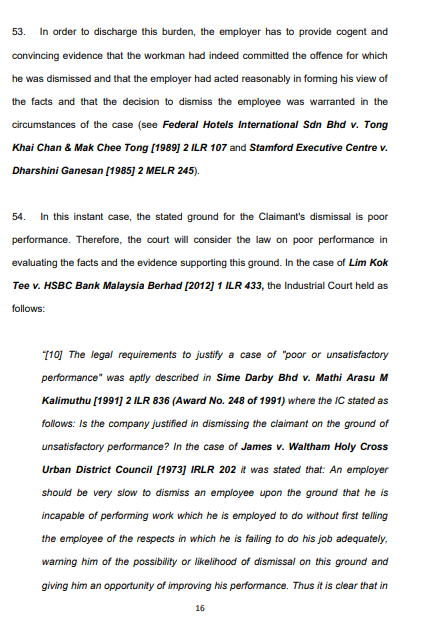

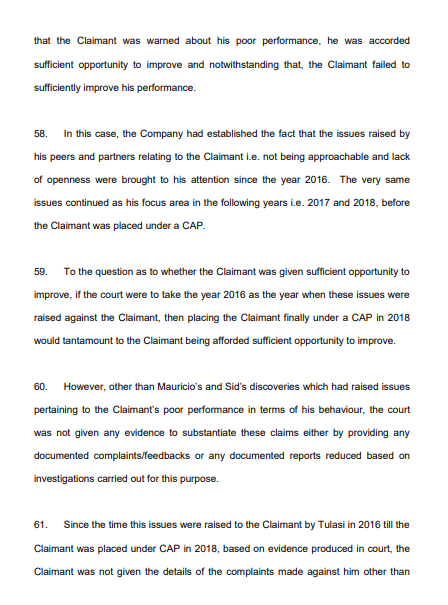
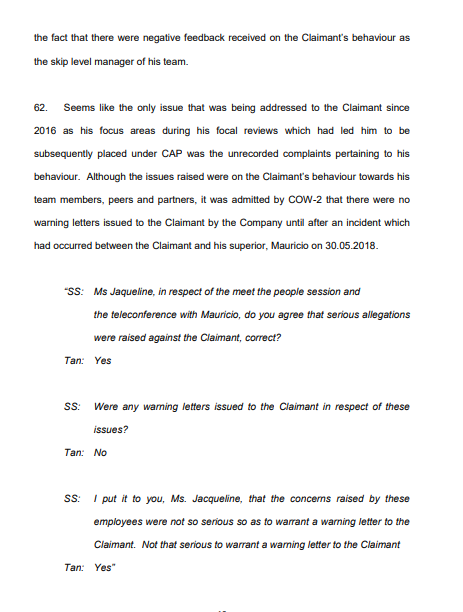
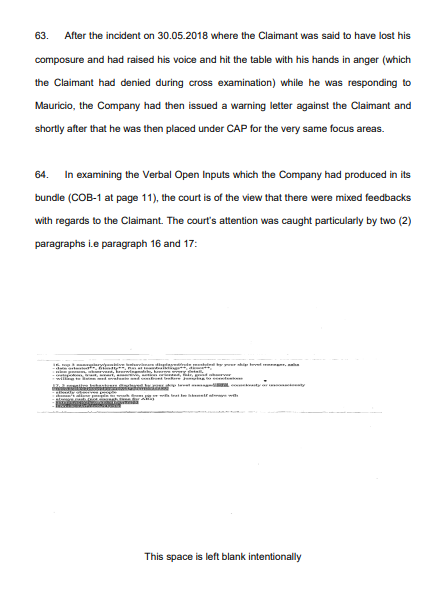
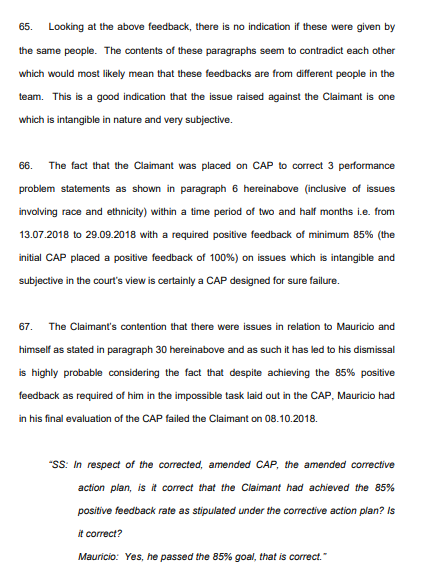
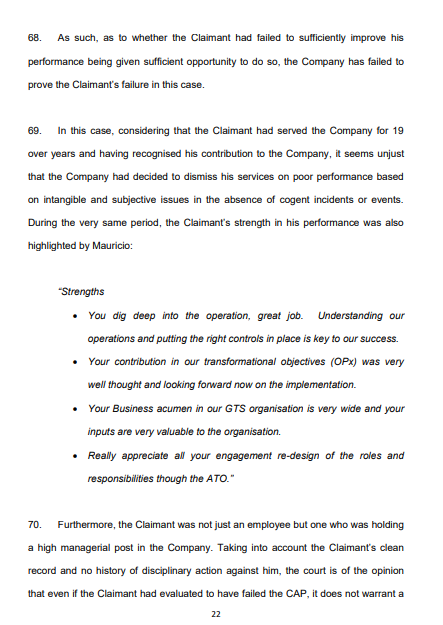

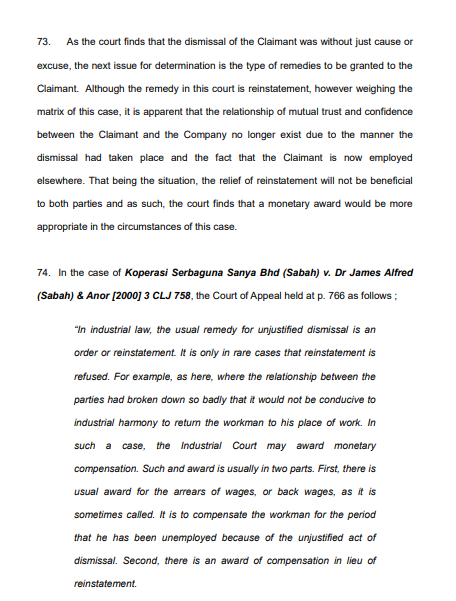
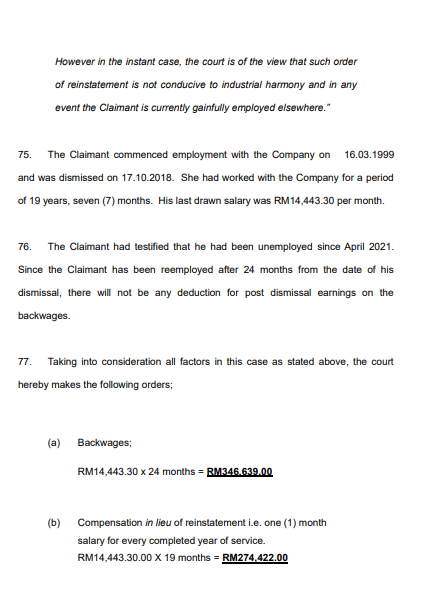

IN THE INDUSTRIAL COURT OF MALAYSIA CASE NO: 19(18)/41753/19 BETWEEN SAHADEVAN A/L BELAIDAN AND INTEL MICROELECTRONICS (M) SDN. BHD. AWARD NO: 2550 OF 2022 Before : Y. A. PUAN SUMATHI MURUGIAH (sitting alone) Venue : Industrial Court of Malaysia Kuala Lumpur Date of Reference :28.08.2019. Dates of Mention :02.10.2019,01.11.2019,22.11.2019,18.12.2019, 17.02.2020, 02.03.2020 \& 07.05.2021. Dates of Hearing :12.05.2021,06.10.2021,07.10.2021,10.12.2021, 13.12.2021, 14.02.2022 \& 15.02.2022. Representation : Mr. Saravanesh Mr. Chuan Wei Jie From Messrs Allen Chee Ram (Counsels for the Claimant) Mr. Donovan Ho Ms. Yannie From Messrs Donovan \& Ho (Counsels for the Company) Reference: The reference under Section 20(3) of the Industrial Relations Act 1967 by the Honourable Minister of Human Resources Malaysia, is regarding the dismissal of Sahadevan a/l Belaidan ("the Claimant") by Intel Microelectronics (M) Sdn. Bhd. ("the Company") on 17.10.2018. AWARD Brief Facts 1. The Claimant commenced his employment with the Company as a Planning Analyst from 16.03.1999. From 2011 onwards, the Claimant held the post of Senior Human Resource (HR) Operations Manager, Global Transactional Services (GTS) at the Company. 2. From May 2017 to 17.10.2018, the Claimant reported to Mauricio Richmond Padilla ("Mauricio") who was the then GTS Global Manager of the Company (who was based in Costa Rica), and who in tum reported to Tulasi Siddhartha ("Tulas) who was the Global Shared Services Director of the Company (which is based in the United States of America). 3. In and around 21.06.2018, the Claimant was contacted by Siddharth Mavinkuve ("Sid") from the Human Resources Department in the process of investigating one of the Claimant's staff and the Claimant himself. 4. On 10.07.2018, the Claimant was invited for a follow-up meeting regarding the investigations by Sid. However, upon the Claimant's arrival at the meeting. Tulasi informed the Claimant that he would receive an OOC IR rating (Out Of Cycle Improvement Required) due to alleged poor performance on his part. 5. The Claimant was placed on Corrective Action Plan (CAP) whereby the first version of the CAP was provided to the Claimant by Mauricio on 12.07.2018. 6. The Company provided a revised CAP (ACAP) to the Claimant on 15.09.2018. The ACAP was largely the same as the CAP with three (3) performance problem statements: 7. The Final Evaluation of the ACAP was carried out on 08.10.2018 by Mauricio but the Claimant had refused to sign the Final Evaluation. On 11.10.2018, an Administrative Inquiry was held at 9.30 am to give the Claimant the opportunity to put forward any further explanation before the Company makes a disposition on the Claimant's case. 8. Pursuant to the Administrative Inquiry, the Company had dismissed the Claimant from his employment vide a termination letter dated 17.10.2018 with immediate effect. The Companvis Case 9. The Claimant had managers working under his leadership and approximately over 36 permanent employees and 30 contingent workers under those managers. 10. As a Grade 8HR Operations Manager (Global Transaction Services), the Claimant was expected, among other things, to set priorities for the team, ensure an inclusive working environment, develop employees and manage the performance of the team members working under him to ensure and drive the team to achieve operational excellence. 11. In August 2016, through an Open Door Investigation ("ODI") about a manager under the Claimant, the Company found that there was an unhealthy tension, general fear or lack of trust within the Claimant's team. 12. Tori Howell (TH) being the Claimant's former superior informed the Claimant of the ODI finding and told him that he "needs to work on trust and being approachable*. 13. When Mauricio took over from TH in May 2017, he received feedback from the Claimant's peers and stakeholders that the Claimant was perceived as "defensive and resistant to different ways to approach the business". 14. This feedback was communicated to the Claimant during a 1-on-1 between the Claimant and Mauricio as well as during the Claimant's quarterly reflection on 20.12.2017. One of the Claimant's identified focus areas was to "reinforce your approach, openness towards new ideas, standardization, were (sic) peers and partners can see you as a positive and inflivential leader" and that it "will be good for you to proactively seek for feedback and look towards to a stronger partnership, were (sic) performance and trust are pillars". 15. Three (3) months later, in March 2018 Mauricio again negative feedback relating to the Claimant and another manager who was reporting to the Claimant. Arising from this a group session was conducted with 10 employees under the Claimant's team. Some of the feedback obtained at the group session included allegations that the Claimant "doesn't listen to other (sic) views, inflexible" and that the Claimant was "stubbom, too strict, self centered". 16. In the Claimant's focal review notification on 16.04.2018 by Mauricio, issues raised by the Claimant's team at a confidential group conversation were highlighted. Areas for improvement for the Claimant was "refine the approach when dealing with stakeholders so that it does not end up as being sensitive or resistant to different approaches" and "Be recognized as an easy partner, peer manager to work with". 17. Subsequently on 30.05.2018 during a meeting with the Claimant, Mauricio gave the Claimant feedback on his performance, the Claimant failed to maintain his composure and raised his voice in anger and hit the table with his hand in anger while responding to Mauricio. 18. After an investigation conducted in June 2018 relating to the Claimant's loss of composure, a written warning was issued to the Claimant on 10.07.2018 for this incident as it was deemed as an "unacceptable behavior". 19. The Claimant was placed on a Corrective Plan Action (CAP) from 13.07.2018 to 13.09.2018. A person outside HR, Gayathri Ramakrishnan was assigned to investigate the Claimant's concern on the CAP based on the complaint made to the Chief Finance Officer and the to the General Counsel by the Claimant alleging inter alia that the CAP was "designed for sure fainure". 20. Based on Gayathri Ramakrishnan's recommendation, the CAP was revised and extended till 27.09.2018. The revised CAP required the Claimant to correct the 3 performance problem statements i.e. creating an action plan to address the ethnicity concerns with in the organization, creating a psychological safe environment and to be perceived as an approachable leader across the organization. 21. At the conclusion of the CAP period after regular 1-on-1 sessions with Mauricio, the Claimant was evaluated as having failed to meet the required expectations and performance standards set under the CAP. The evaluation was also done based on the results from a 360 - degree feedback process. 22. After the CAP, an independent administrative inquiry was held comprising of 2 panel members, a senior member from Business Group and another HR Manager from a different department) who examined the facts of the CAP and all relevant documentations including the Claimant's explanations in respect of the CAP. 23. The independent administrative inquiry panel confirmed that the Claimant did not meet the criteria for CAP closure and as such the Claimant's employment was terminated by the Company effective 17.10.2018. 24. The Company had called four (4) witnesses to give evidence on its behalf at the trial. They are: i. Mauricio Richmond Padilla (COW-1) - IT Project/Program Manager (Formerly, Global Manager (Global Transaction Services) with the Company; ii. Jacqueline Tan Soh Quin (COW-2) - HR Manager HR4HR in the Business HR Department of the Company; iii. Indranil Bhattacharyya (COW-3) - Finance Director of the Company; and iv. Gayathri Devi a/p Ramakrishnan ( COW-4) - Regional Employment LegalCounsel. 25. As the Senior Human Resources Operations Manager, Global Transactional Services (GTS) from 2011, the Claimant headed the entire Malaysian Chapter of the GTS function within the HR Global Shared Services group in the Company. 26. The Claimant's team managed/handled support for the entire Greater Asia Region (GAR) region comprising of 7 different countries and certain global processes where Intel had an employee presence. 27. In 2017, GTS's scope was expanded with the integration of another team, IPOCC into the GTS. As at 17.10.2018, the Claimant headed a team comprising of 33 Company staffs and 30 Vendor staffs. 28. The Claimant owned the Human Resources space planner role since 2012 and managed the successful relocation of 250 staffs through major building moves. 29. From May 2017 to 17.10.2018, the Claimant reported to Mauricio who was the then GTS Global Manager of the Company and who in turn reported to Tulasi who was the Global Shared Services Director of the Company (based in the United States of America). 30. It is the Claimant's contention that the events predicating and leading to the dismissal began when: i. the Claimant had disagreed to Mauricio insisting that in the event of any escalation (i.e. the occurrence of high severity issues informed to, discovered by or due to the GTS team) that Mauricio be always notified first despite him being in a different time zone; ii. The Claimant's had raised his concern with Tulasi with regards to the Should Cause Model (the Company's method of allocating resources to the various departments) that would affect the promotions of staffs; iii. The Claimant had disagreed during discussions with Mauricio on whether the indicators regarding issues that were raised by the Company staffs to the HR Department be 'manipulated' in order to improve the team's performance/rating as this had contravened the Company's established protocols/rules; and iv. The alleged favoritism that was shown towards certain staff of the Company by Mauricio. 31. The Claimant had questioned Mauricio on his lack of honestly on two (2) occasions: i. Mauricio had agreed with the Claimant whilst he was still in Costa Rica that he would personally carry out when he came over to Malaysia a crucial oral sharing session with the Malaysian Chapter of the GTS. 9 However, Mauricio changed and claimed during his trip to Malaysia that the Claimant should have carried out the sharing session on his own instead. Mauricio even asserted that the Claimant's failure to do so constituted an area for improvement; and ii. During the annual performance/focal review that were conducted by Mauricio for the Claimant in 2018, Mauricio had dishonestly claimed that he had done his best to increase the Claimant's increments, bonuses and stock options (beyond what the Company's system would allow). This was untrue and the Claimant had subsequently pointed this out to Mauricio during the review itself. 32. Subsequent to all the above, the Claimant was contacted by Sid in or around 21.06.2018 with regards to issues which needed to be investigated. However, the Claimant never received any written report regarding the 'issues' that led to the said investigation and neither did the Claimant receive the findings of the aforesaid investigations by Sid. 33. On 10.07.2018, the Claimant was informed by Tulasi that per the investigations that had been carried out, the Claimant would receive an OCC IR rating (which the Claimant had never received throughout his 19 years with the Company) due to alleged poor performance on his part. 34. In relation to this rating, Tulasi had informed the Claimant that it would be best if the Claimant accepted the six (6) months buyout option (i.e. that he should resign voluntarily with 6 months' salary) instead of ploughing through the Corrective Action Plan. 35. The Claimant was then placed under CAP which was provided to him by Mauricio on 12.07.2018. A revised CAP (ACAP) was then provided to the Claimant after he raised his grievance towards the CAP on 15.09.2018. 36. The CAP and ACAP was largely the same, save that: i. The Claimant would have to achieve 85% positive feedback rate (previous CAP it was 100% ) for certain metrics under the CAP; and ii. That a 360 feedback would be carried out by Mauricio from numerous parties regarding the Claimant. 37. The Claimant refused to sign the CAP and the ACAP, inter alia on the basis that: i. The contents of the CAP and the ACAP were incorrectinaccurate; ii. The CAP and the ACAP was 'planned' for failure from the onset and contained highly rigid metrics ( with very minimal chance of success); iii. The evaluation of the CAP and ACAP and the surveys therein were subjective in nature and open to abuse; V. The CAP and ACAP were vague, uncertain, subjective, unfair, baseless, frivolous, vexatious and/or a complete form of harassment and persecution of the Claimant, and vi. That it would be nearly impossible for the Claimant to achieve 100% or 85% positive feedback for the CAP and zero escalations from numerous parties. 38. Despite the above and the challenges faced, the Claimant strove to obtain positive feedback for the CAP and zero validation escalations as required. However, on 08.10.2018, the Final Evaluation of the ACAP was carried out. 39. On 08.10.2018, the Final Evaluation of the ACAP was carried out by Mauricio who claimed that CAP was incomplete/unsuccessful although the Claimant had surpassed the 85% positive feedback as required under the CAP. 40. The Claimant contends that Mauricio had failed, refused and/or intentionally neglected to review/respond to the items stated in the CAP and its status in 1-to-1 meetings with the Claimant throughout the CAP duration until closure, which was expected of him as the manager under the Company's CAP process. 41. During the CAP, the Claimant was not provided with sufficient opportunity to improve his alleged poor performance in terms of support feedback by Mauricio, sufficient time and/or room. 42. Although the Claimant had refused to sign the Final Evaluation of the ACAP, no action was taken against the Claimant's refusal by the Company. As such, it is the Claimant's contention that by this, it undoubtedly shows that the said allegation and cause to issue the final ACAP was baseless, frivolous, vexatious and a complete form of harassment and persecution of the Claimant. 43. On 08.10.2018, the Claimant received a notice from Mauricio stating that an Administrative Inquiry would be held on 11.10.2018 to give the Claimant an opportunity to put forward any further explanation before the Company makes a disposition on the Claimant's case. 44. Pursuant to the Administrative Inquiry that was carried out on 11.10.2018, the Company proceeded to immediately dismiss and terminate the Claimant on 17.10.2018 on the basis that the Claimant did not meet the performance requirements and expectations. 45. The Claimant pleads that the Company in dismissing him based on reasons as aforesaid was just a ploy and maneuver orchestrated by the Company to dismiss and/or benefits. 46. The Claimant was the sole witness for his case. 47. Based on both the parties' case as stated above, it is apparent that the two (2) questions which the court has to ask itself are : (i) was there a dismissal; and (ii) if the answer to (i) is in the affirmative, was the dismissal with or without just cause or excuse. 48. As stated in the case of Wong Chee Hong v. Cathay Organisation (M) Sdn. Bhd. [1988] 1 CLJ 45; [1988] 1 CLJ (Rep) 298 by the then Supreme Court as follows : "When the Industrial Court is dealing with a reference under S 20, the first thing that the court will have to do is to ask itself a question whether there was a dismissal, and if so, whether it was with or without just cause or excuse." 49. In this case, the fact of dismissal is not disputed. Therefore, the only issue which is left to be deliberated before this court is whether the dismissal of the Claimant by the Bank was with just cause or excuse. 50. Having established that there is a dismissal, the principals in the Federal Court case of Wong Yuen Hock v Syarikat Hong Leong Assurance Sdn Bhd \& Anor [1995] CLJ 344 is now being referred. In this case it was held that :- "On the authorities, we were of the view that the main and only function of the Industrial Court is dealing with a reference under section 20 of the Act (unless otherwise lawfully provided by the terms of the reference), is to determine whether the misconduct or irregularities complained of by the Management as the grounds of dismissal were in fact committed by the workman, and if so, whether such grounds constitute just cause or excuse for the dismissal." The Law 51. Following the principles laid down by the Federal Court in the case of Goon Kwee Phoy v. J \& P Coats (M) Bhd [1981] 1 LNS 30; [1981] 2 MLJ 129, it is the duty of the court to enquire into the reason advanced by the employer for the dismissal of the workman and if it finds that the stated reason has not been proven, then the inevitable conclusion must be that the termination or dismissal was without just cause or excuse. 52. The burden rests on the employer to prove that the dismissal of the employee from his service was with just cause or excuse and this burden must be discharged on a standard of proof of balance of probabilities (see Telekom Malaysia Kawasan Utara v. Krishnan Kutty Sanguni Nair \& Anor [2002] 3 CLJ 314). 53. In order to discharge this burden, the employer has to provide cogent and convincing evidence that the workman had indeed committed the offence for which he was dismissed and that the employer had acted reasonably in forming his view of the facts and that the decision to dismiss the employee was warranted in the circumstances of the case (see Federal Hotels International Sdn Bhd v. Tong Khai Chan \& Mak Chee Tong [1989] 2 ILR 107 and Stamford Executive Centre v. Dharshini Ganesan [1985] 2 MELR 245). 54. In this instant case, the stated ground for the Claimant's dismissal is poor performance. Therefore, the court will consider the law on poor performance in evaluating the facts and the evidence supporting this ground. In the case of Lim Kok Tee v. HSBC Bank Malaysia Berhad [2012] 1 ILR 433, the Industrial Court held as follows: [10] The legal requirements to justify a case of "poor or unsatisfactory performance" was aptly described in Sime Darby Bhd v. Mathi Arasu M Kalimuthu [1991] 2 ILR 836 (Award No. 248 of 1991) where the IC stated as follows: Is the company justified in dismissing the claimant on the ground of unsatisfactory performance? In the case of James v. Waltham Holy Cross Urban District Council [1973] IRLR 202 it was stated that: An employer should be very slow to dismiss an employee upon the ground that he is incapable of performing work which he is employed to do without first telling the employee of the respects in which he is failing to do his job adequately, waming him of the possibility or likelihood of dismissal on this ground and giving him an opportunity of improving his performance. Thus it is clear that in 16 order to justify the dismissal, the company has to establish three things. Firstly, that the Claimant was warned about his unsatisfactory 18 performances, secondly that the claimant was accorded sufficient opportunity to improve and thirdly, notwithstanding the above, the claimant failed to sufficiently improve his performance." 55. As such, the Company would need to establish the followings in order to justify the dismissal of the Claimant's service with the Company on the ground of poor performance: i. that the Claimant was warned about his poor performance; ii. that the Claimant was accorded sufficient opportunity to improve; and iii. that notwithstanding the above the Claimant failed to sufficiently improve his performance. The Evaluation and Findings 56. In this case, based on the facts given, the Company's dissatisfaction with the Claimant's work performance was in relation to the Claimant being unapproachable to his peers and partners and not on any other aspect of his performance based on his job scope. 57. In applying the principles laid down in the case of James v. Waltham Holy Cross Urban District Council (supra), the Company has the burden to establish that the Claimant was warned about his poor performance, he was accorded sufficient opportunity to improve and notwithstanding that, the Claimant failed to sufficiently improve his performance. 58. In this case, the Company had established the fact that the issues raised by his peers and partners relating to the Claimant i.e. not being approachable and lack of openness were brought to his attention since the year 2016. The very same issues continued as his focus area in the following years i.e. 2017 and 2018 , before the Claimant was placed under a CAP. 59. To the question as to whether the Claimant was given sufficient opportunity to improve, if the court were to take the year 2016 as the year when these issues were raised against the Claimant, then placing the Claimant finally under a CAP in 2018 would tantamount to the Claimant being afforded sufficient opportunity to improve. 60. However, other than Mauricio's and Sid's discoveries which had raised issues pertaining to the Claimant's poor performance in terms of his behaviour, the court was not given any evidence to substantiate these claims either by providing any documented complaints/feedbacks or any documented reports reduced based on investigations carried out for this purpose. 61. Since the time this issues were raised to the Claimant by Tulasi in 2016 till the Claimant was placed under CAP in 2018 , based on evidence produced in court, the Claimant was not given the details of the complaints made against him other than the fact that there were negative feedback received on the Claimant's behaviour as the skip level manager of his team. 62. Seems like the only issue that was being addressed to the Claimant since 2016 as his focus areas during his focal reviews which had led him to be subsequently placed under CAP was the unrecorded complaints pertaining to his behaviour. Although the issues raised were on the Claimant's behaviour towards his team members, peers and partners, it was admitted by COW-2 that there were no warning letters issued to the Claimant by the Company until after an incident which had occurred between the Claimant and his superior, Mauricio on 30.05.2018. "SS: Ms Jaqueline, in respect of the meet the people session and the teleconference with Mauricio, do you agree that serious allegations were raised against the Claimant, correct? Tan: Yes SS: Were any waming letters issued to the Claimant in respect of these issues? Tan: No SS: I put it to you, Ms. Jacqueline, that the concerns raised by these employees were not so serious so as to warrant a warning letter to the Claimant. Not that serious to warrant a waming letter to the Claimant Tan: Yes" 63. After the incident on 30.05.2018 where the Claimant was said to have lost his composure and had raised his voice and hit the table with his hands in anger (which the Claimant had denied during cross examination) while he was responding to Mauricio, the Company had then issued a warning letter against the Claimant and shortly after that he was then placed under CAP for the very same focus areas. 64. In examining the Verbal Open Inputs which the Company had produced in its bundle (COB-1 at page 11), the court is of the view that there were mixed feedbacks with regards to the Claimant. The court's attention was caught particularly by two (2) paragraphs i.e paragraph 16 and 17: This space is left blank intentionally 65. Looking at the above feedback, there is no indication if these were given by the same people. The contents of these paragraphs seem to contradict each other which would most likely mean that these feedbacks are from different people in the team. This is a good indication that the issue raised against the Claimant is one which is intangible in nature and very subjective. 66. The fact that the Claimant was placed on CAP to correct 3 performance problem statements as shown in paragraph 6 hereinabove (inclusive of issues involving race and ethnicity) within a time period of two and half months i.e. from 13.07.2018 to 29.09.2018 with a required positive feedback of minimum 85% (the initial CAP placed a positive feedback of 100% ) on issues which is intangible and subjective in the court's view is certainly a CAP designed for sure failure. 67. The Claimant's contention that there were issues in relation to Mauricio and himself as stated in paragraph 30 hereinabove and as such it has led to his dismissal is highly probable considering the fact that despite achieving the 85% positive feedback as required of him in the impossible task laid out in the CAP, Mauricio had in his final evaluation of the CAP failed the Claimant on 08.10.2018. "SS: In respect of the corrected, amended CAP, the amended corrective action plan, is it correct that the Claimant had achieved the 85% positive feedback rate as stipulated under the corrective action plan? Is it correct? Mauricio: Yes, he passed the 85% goal, that is correct." 68. As such, as to whether the Claimant had failed to sufficiently improve his performance being given sufficient opportunity to do so, the Company has failed to prove the Claimant's failure in this case. 69. In this case, considering that the Claimant had served the Company for 19 over years and having recognised his contribution to the Company, it seems unjust that the Company had decided to dismiss his services on poor performance based on intangible and subjective issues in the absence of cogent incidents or events. During the very same period, the Claimant's strength in his performance was also highlighted by Mauricio: 'Strengths - You dig deep into the operation, great job. Understanding our operations and putting the right controls in place is key to our success. - Your contribution in our transformational objectives (OPx) was very well thought and looking forward now on the implementation. - Your Business acumen in our GTS organisation is very wide and your inputs are very valuable to the organisation. - Really appreciate all your engagement re-design of the roles and responsibilities though the ATO." 70. Furthermore, the Claimant was not just an employee but one who was holding a high managerial post in the Company. Taking into account the Claimant's clean record and no history of disciplinary action against him, the court is of the opinion that even if the Claimant had evaluated to have failed the CAP, it does not warrant a dismissal. The punishment of dismissal is too harsh considering the circumstances of this case and the years of service he has behind him with the Company. 71. In the Indian Supreme Court case of Der Singh v. Punjab Tourism Development Corporation Ltd. \& Anor [2003] A.I.R. 3712 S.C. where Mr. Justice Santosh Hedge held at page 3713 : "A perusal of the above judgments clearly shows that a Court sitting on appeal against a punishment imposed in the disciplinary proceedings will not normally substitute its own conclusion on penalty, however if punishment imposed by the disciplinary authority or the appellate authority shocks the conscience of the Court, then the Court would appropriately mould the relief either by directing the disciplinary/appropriate authority to reconsider the penalty. It is also clear from the above noted judgments of this Court, if the punishment imposed by the disciplinary authority is totally disproportionate to the misconduct proved against the delinquent officer, then the Court would interfere in such a case" Conclusion and Remedy 72. Based on the foregoing, it is the court's findings bearing in mind S30(5) of the IRA, 1967 to act according to equity, good conscience and the substantial merits of the case without regard to technicalities and legal form, the Company has failed to prove on balance of probabilities that the Claimant's dismissal was with just cause or excuse. 73. As the court finds that the dismissal of the Claimant was without just cause or excuse, the next issue for determination is the type of remedies to be granted to the Claimant. Although the remedy in this court is reinstatement, however weighing the matrix of this case, it is apparent that the relationship of mutual trust and confidence between the Claimant and the Company no longer exist due to the manner the dismissal had taken place and the fact that the Claimant is now employed elsewhere. That being the situation, the relief of reinstatement will not be beneficial to both parties and as such, the court finds that a monetary award would be more appropriate in the circumstances of this case. 74. In the case of Koperasi Serbaguna Sanya Bhd (Sabah) v. Dr James Alfred (Sabah) \& Anor [2000] 3 CLJ 758, the Court of Appeal held at p. 766 as follows ; "In industrial law, the usual remedy for unjustified dismissal is an order or reinstatement. it is only in rare cases that reinstatement is refused. For example, as here, where the relationship between the parties had broken down so badly that it would not be conducive to industrial harmony to retum the workman to his place of work. In such a case, the Industrial Court may award monetary compensation. Such and award is usually in two parts. First, there is usual award for the arrears of wages, or back wages, as it is sometimes called. It is to compensate the workman for the period that he has been unemployed because of the unjustified act of dismissal. Second, there is an award of compensation in lieu of reinstatement. However in the instant case, the court is of the view that such order of reinstatement is not conducive to industrial harmony and in any event the Claimant is cumently gainfully employed elsewhere." 75. The Claimant commenced employment with the Company on 16.03.1999 and was dismissed on 17.10.2018. She had worked with the Company for a period of 19 years, seven (7) months. His last drawn salary was RM14,443.30 per month. 76. The Claimant had testified that he had been unemployed since April 2021. Since the Claimant has been reemployed after 24 months from the date of his dismissal, there will not be any deduction for post dismissal earnings on the backwages. 77. Taking into consideration all factors in this case as stated above, the court hereby makes the following orders; (a) Backwages; RM14,443.3024months=RM346,63,9,00 (b) Compensation in lieu of reinstatement i.e. one (1) month salary for every completed year of service. RM14,443.30.0019months=RM274.422.00 78. Therefore, Company is hereby ordered to pay the sum of RM621,061.00 (RM346,639.00 + RM274,422.00.00) less any statutory deduction, if any, to the Claimant within 30 days from the date of this Award. HANDED DOWN AND DATED THIS 01st DAY OF DECEMBER, 2022 -signed- ( SUMATHI MURUGIAH) CHAIRMAN INDUSTRIAL COURT OF MALAYSIA KUALA LUMPUR
































